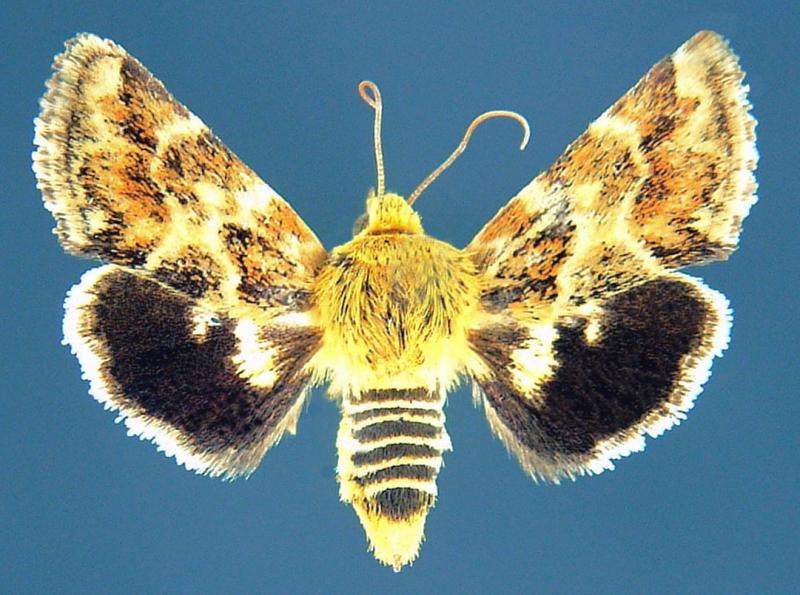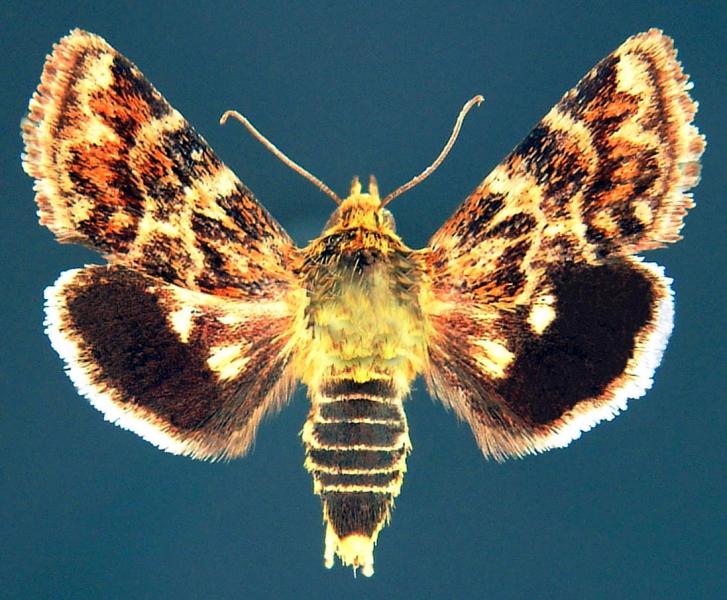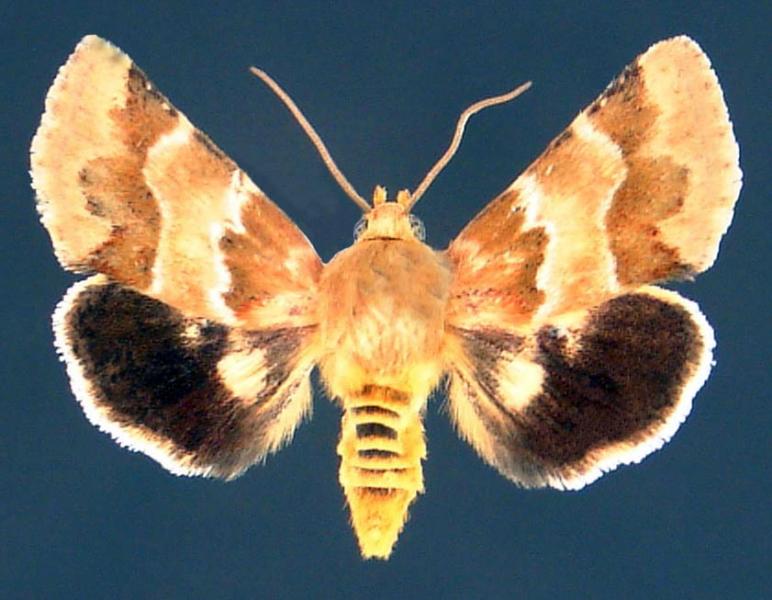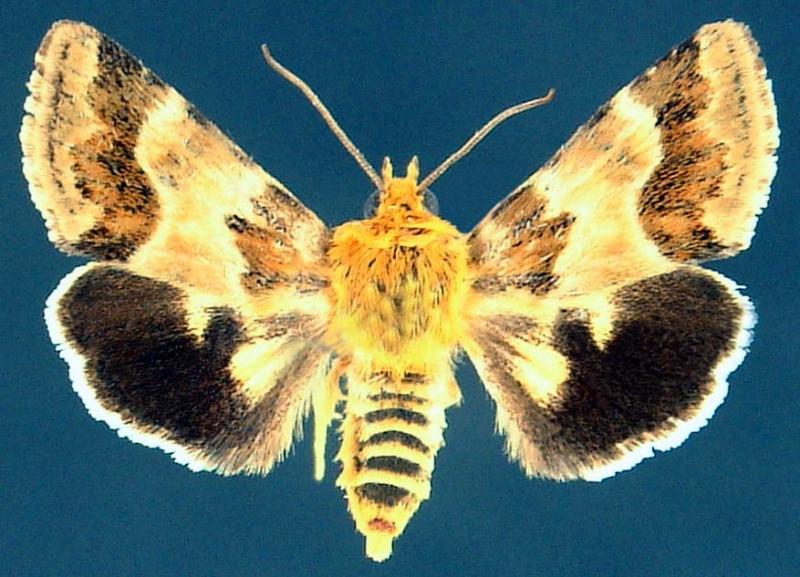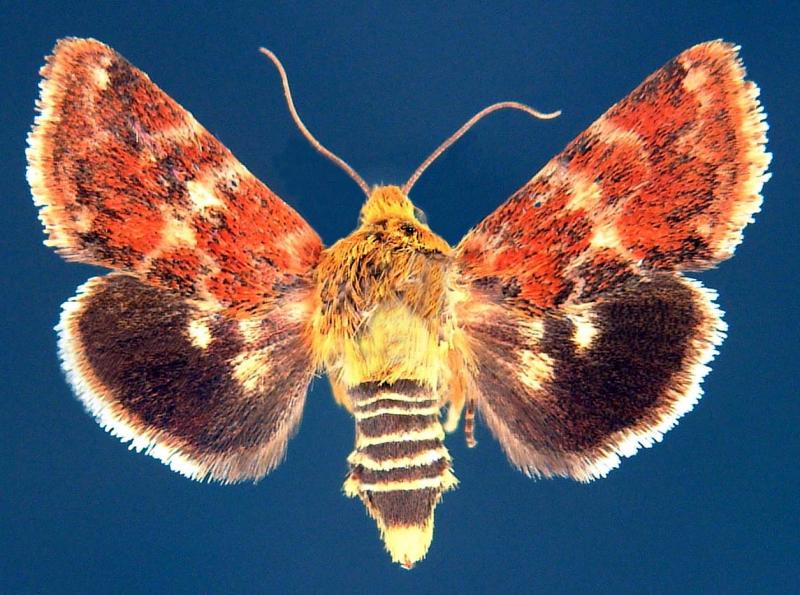Golden Aster Flower Moth
Schinia tuberculum (Hübner, [1831])
- Class
- Insecta (Insects)
- Family
- Noctuidae (Owlet Moths)
- State Protection
- Not Listed
Not listed or protected by New York State.
- Federal Protection
- Not Listed
- State Conservation Status Rank
- S1
Critically Imperiled in New York - Especially vulnerable to disappearing from New York due to extreme rarity or other factors; typically 5 or fewer populations or locations in New York, very few individuals, very restricted range, very few remaining acres (or miles of stream), and/or very steep declines.
- Global Conservation Status Rank
- G4
Apparently Secure globally - Uncommon in the world but not rare; usually widespread, but may be rare in some parts of its range; possibly some cause for long-term concern due to declines or other factors.
Summary
Did you know?
Schinia is one of the largest and most successful genera of Lepidoptera, containing more than 120 species in North America (Wagner et al. 2008).
Conservation and Management
Conservation Strategies and Management Practices
Areas where this species has been found should be evaluated to avoid additional encroachment or fragmentation by development. In addition, minimizing lighting to maintain dark sky conditions would be beneficial.
Habitat
Habitat
The golden aster flower moth is found in dry sandy areas that contain an abundance of its food source, Pityopsis falcata (sickle-leaf golden-aster, sickle-leaf silkgrass). P. falcata has yellow flowers, is found in dry sandy areas near the coast and in pine barrens, and flowers from July to September. Although this moth is found in barren-type habitats, it is not considered a barrens species, since it can also inhabit other habitat types.
Associated Ecological Communities
- Pitch pine-oak-heath woodland
(guide)
A pine barrens community that occurs on well-drained, infertile, sandy soils. The structure of this community is intermediate between a shrub-savanna and a woodland. Pitch pine and white oak are the most abundant trees.
Range
Global Distribution
This moth is found in the eastern United States from New York to Florida and west to Oklahoma and Texas (Heppner 2003). The moth appears to be rare in New York, and records of the species in Massachusetts are historical (NatureServe 2010). Currently its main range extends from South Carolina to Florida and westward.
Best Places to See
- Dwarf Pine Barrens (Suffolk County)
Identification Comments
Identifying Characteristics
The golden aster flower moth is cryptically colored. Similar to many other flower moths (Wagner et al. 2008), its coloration is variable. In fact, seven different variations in appearance (phenotype) have been documented in Louisiana (V. Brou, personal communication). The forewings usually contain various shades of gold or red, and the hind wings usually are predominantly dark brown. Both the forewings and hind wings contain pale patches. The wingspan is approximately 20 mm. Males seem to have larger wings than females, and the pattern on the forewings of males and females is different (Brou 2006).
Best Life Stage for Proper Identification
The adult is the best life stage for identification.
Behavior
This moth species has one annual generation. It is active both during the day (from the late morning to the afternoon) and at night (Hardwick 1996). During the day, it can be found resting on the stems and flower stalks, or feeding on the flowers, of its food source, Pityopsis falcata (sickle-leaf golden-aster, sickle-leaf silkgrass) (Wagner et al. 2008). At night, it is easily taken at light (Hardwick 1996).
Diet
In New York State, the food source of the golden aster flower moth is Pityopsis falcata (sickle-leaf golden-aster, sickle-leaf silkgrass). Elsewhere in its range, P. graminifolia (narrowleaf silkgrass) has also been recorded as one of its food sources (Wagner et al. 2008), but this species does not occur in New York State.
Best Time to See
The best time to see golden aster flower moths is during their flight season. In New York State, the moths have been documented to fly from late July to mid September.
- Present
- Reproducing
The time of year you would expect to find Golden Aster Flower Moth present and reproducing in New York.
Golden Aster Flower Moth Images
Taxonomy
Golden Aster Flower Moth
Schinia tuberculum (Hübner, [1831])
- Kingdom Animalia
- Phylum Arthropoda
(Mandibulates)
- Class Insecta
(Insects)
- Order Lepidoptera
(Butterflies, Skippers, and Moths)
- Family Noctuidae (Owlet Moths)
- Order Lepidoptera
(Butterflies, Skippers, and Moths)
- Class Insecta
(Insects)
- Phylum Arthropoda
(Mandibulates)
Comments on the Classification
In Covell (1984), an illustration of Schnia septentrionalis is mislabeled as Schinia tuberculum.
Additional Resources
References
Brou Jr., Vernon A. 2006. Schinia tuberculum (Hubner) in Louisiana. South. Lepid. News 28:33-34.
Covell, Charles V. 1984. A field guide to the moths of eastern North America. Houghton Mifflin Company, Boston.
Hardwick, D. F. 1996. A monograph of the New World Heliothentinae (Lepidoptera: Noctuidae). Centre for Land and Biological Resources Research, Agriculture Canada, Ottawa Canada. 281 pp., 24 color plates.
Heppner, J.B. 2003. Lepidoptera of Florida. Part 1. Introduction and catalog. Arthropods of Florida and Neighboring Areas. Volume 17. Florida Department of Agriculture and Consumer Services, Gainesville. 670 p.
NatureServe. 2010. NatureServe Explorer: An online encyclopedia of life [web application]. Version 7.1. NatureServe, Arlington, Virginia. Available http://www.natureserve.org/explorer. (Data last updated August 2010)
New York Natural Heritage Program. 2024. New York Natural Heritage Program Databases. Albany, NY.
North American Moth Photographers Group at the Mississippi Entomological Museum. No date. Mississippi State University, Mississippi. http://mothphotographersgroup.msstate.edu/MainMenu.shtml
Opler, Paul A., Kelly Lotts, and Thomas Naberhaus, coordinators. 2010. Butterflies and Moths of North America. Bozeman, MT: Big Sky Institute. <http://www.butterfliesandmoths.org/> (accessed May 2010).
Schweitzer, Dale F. 1998. Rare, potentially rare, and historic macrolepidoptera for Long Island, New York: A suggested inventory list.
Wagner, D. L., D. F. Schweitzer, J. B. Sullivan, and R. C. Reardon. 2008. Owlet Caterpillars of Eastern North America (Lepidoptera: Noctudiae)
Links
About This Guide
This guide was authored by: Andrea Chaloux
Information for this guide was last updated on: March 7, 2012
Please cite this page as:
New York Natural Heritage Program. 2024.
Online Conservation Guide for
Schinia tuberculum.
Available from: https://guides.nynhp.org/golden-aster-flower-moth/.
Accessed April 25, 2024.
